Virginia’s woodlands resonate with nine distinct woodpecker species’ rhythmic drumming and vibrant plumage.
From the iconic Pileated Woodpecker to the elusive Red-cockaded Woodpecker, these avian marvels contribute to the state’s ecological diversity.
This exploration unveils the rich tapestry of woodpecker life in Virginia, highlighting their unique characteristics, habitats, and the imperative role they play in maintaining the health of our forests.
Delve into the world of these skilled tree-drummers, understanding the challenges they face and the conservation efforts required to ensure their continued presence.
Virginia’s woodpeckers are more than just ornithological wonders; they embody the delicate balance of nature, making their preservation essential for the sustained vitality of the Old Dominion’s ecosystems. Stay focused.
9 Woodpeckers of Virginia
Woodpeckers play a crucial ecological role in Virginia by contributing to forest health. Their foraging activities control insect populations, while cavity excavation provides nesting sites for various species.
Explore the vibrant avian tapestry of Virginia through this concise bird list featuring woodpeckers that grace the state’s diverse ecosystems.
From the striking Red-headed Woodpecker to the unique forager, Yellow-bellied Sapsucker, each species contributes to the rich birdlife, offering a glimpse into their varied habitats and challenges.
1. Pileated Woodpecker
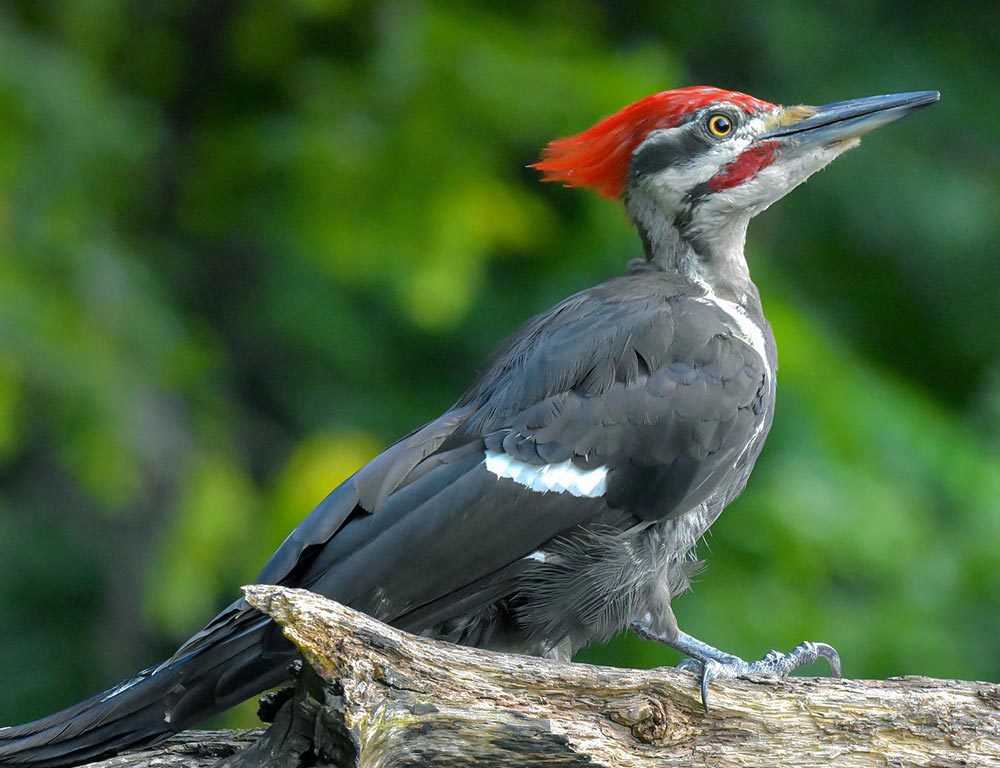
- Scientific Name: Dryocopus pileatus
- Category: Woodpecker
- Population: Stable
- Life Span: 5-10 years
- Size: 16-19 inches
- Weight: 8-12 ounces
- Food: Insects, fruits, and occasionally small vertebrates
- Wingspan: 26-30 inches
- Status: Least Concern
The Pileated Woodpecker, with its striking red crest and large size, is one of the most impressive woodpeckers in Virginia.
Their strong bills are adapted for excavating insects from dead trees, and their drumming sounds resonate through the forest. Pileated woodpeckers are territorial and prefer mature forests with plenty of dead wood.
They carve out large rectangular holes in trees as they search for carpenter ants and beetles. Their distinct call and vibrant appearance make them a sought-after sighting for birdwatchers.
2. Downy Woodpecker
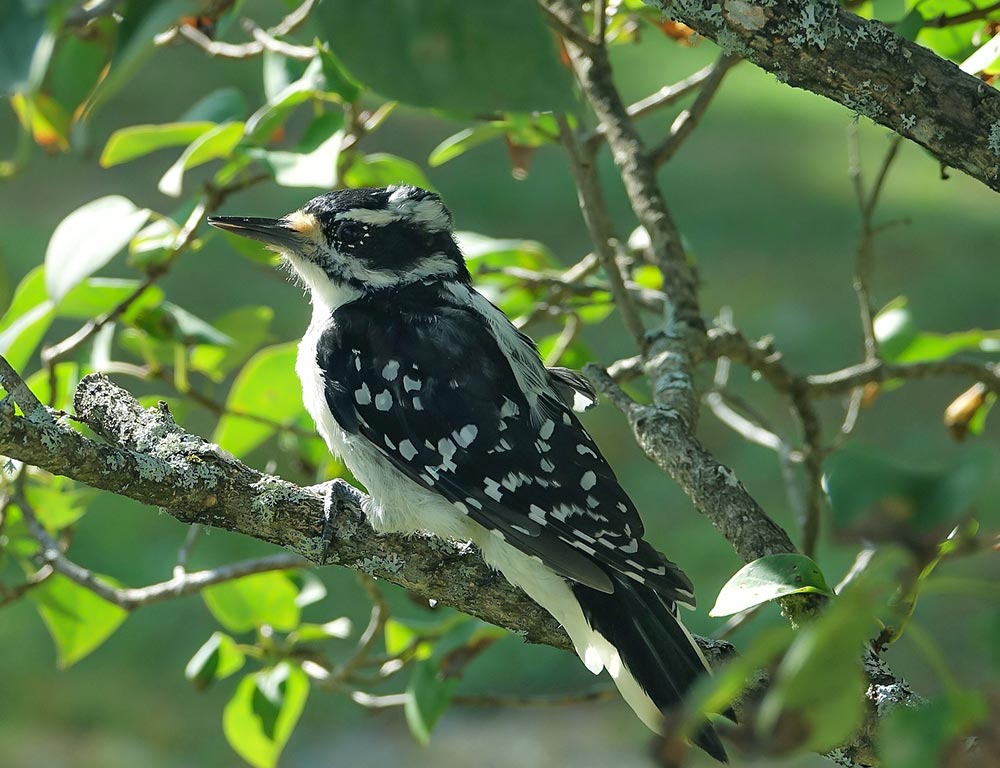
- Scientific Name: Dryobates pubescens
- Category: Woodpecker
- Population: Abundant
- Life Span: 4-6 years
- Size: 5.5-7 inches
- Weight: 0.7-1 ounce
- Food: Insects, seeds, and berries
- Wingspan: 9-12 inches
- Status: Least Concern
The Downy Woodpecker, Virginia’s smallest woodpecker, is a delightful and easily identifiable bird with its classic black and white feather pattern. Despite its diminutive size, its drumming resonates through woodlands and suburban landscapes alike.
Thriving in diverse habitats, from dense forests to residential areas, Downy Woodpeckers exhibit remarkable adaptability. These agile birds predominantly feed on various insects, seeds, and berries.
Their petite stature grants them the ability to navigate twigs and branches expertly in search of hidden prey. Notably, these charming woodpeckers are frequent visitors to suet feeders in residential backyards, bringing their lively presence closer to human observers.
The Downy Woodpecker’s versatility and adaptability make it a cherished and ubiquitous inhabitant of Virginia’s natural and urban environments.
3. Red-headed Woodpecker
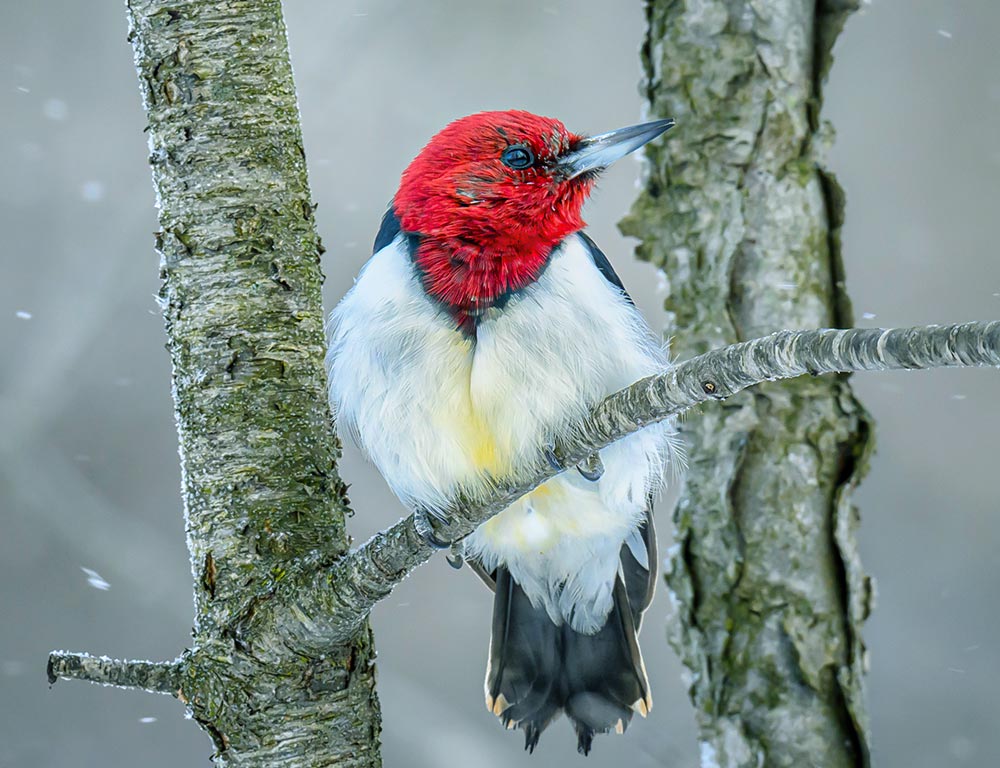
- Scientific Name: Melanerpes erythrocephalus
- Category: Woodpecker
- Population: Declining
- Life Span: 9-12 years
- Size: 7.5-9.25 inches
- Weight: 2.5-3.4 ounces
- Food: Insects, fruits, nuts, and small vertebrates
- Wingspan: 16.5-17.7 inches
- Status: Near Threatened
The Red-headed Woodpecker, characterized by its dazzling redhead, stark white body, and contrasting black wings, is a remarkable avian species in Virginia.
Regrettably, this bird confronts a declining population attributed to habitat loss. Renowned for its acrobatic foraging techniques, the Red-headed Woodpecker skillfully captures insects mid-air and stashes excess food in tree crevices.
This species predominantly inhabits open woodlands, orchards, and savannas, showcasing its adaptability. Conservation endeavors are paramount to securing this stunning woodpecker’s continued existence in Virginia.
Preserving and restoring suitable habitats are critical measures to counteract the threats posed by habitat loss and ensure the Red-headed Woodpecker’s thriving presence in the state’s diverse ecosystems.
4. Red-cockaded Woodpecker
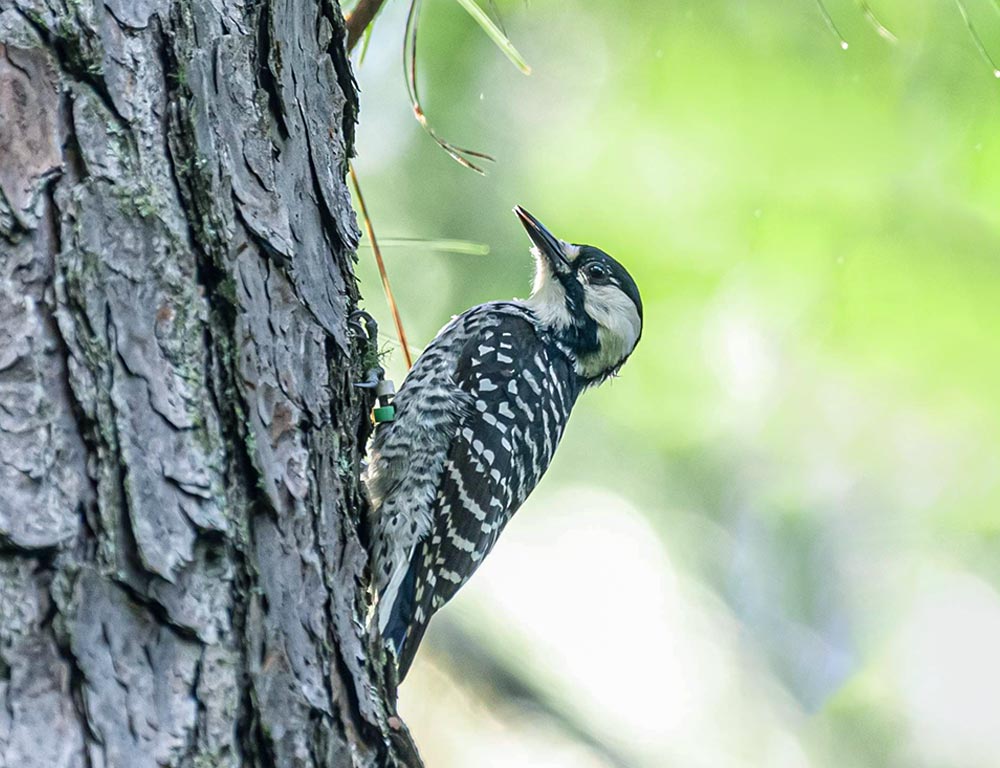
- Scientific Name: Picoides borealis
- Category: Woodpecker
- Population: Declining
- Life Span: 4-10 years
- Size: 7-9 inches
- Weight: 1-1.5 ounces
- Food: Insects, especially wood-boring beetles
- Wingspan: 13-16 inches
- Status: Endangered
The Red-cockaded Woodpecker is a small woodpecker with a unique social structure. Recognizable by its black and white plumage, males have a small red streak, or “cockade,” on their heads.
This species is specialized in foraging for insects in pine trees, particularly those infected by pine beetles.
Red-cockaded Woodpeckers are cooperative breeders, with family groups working together to raise chicks. Habitat loss, particularly the decline of mature pine forests, poses a significant threat to their survival.
5. Hairy Woodpecker
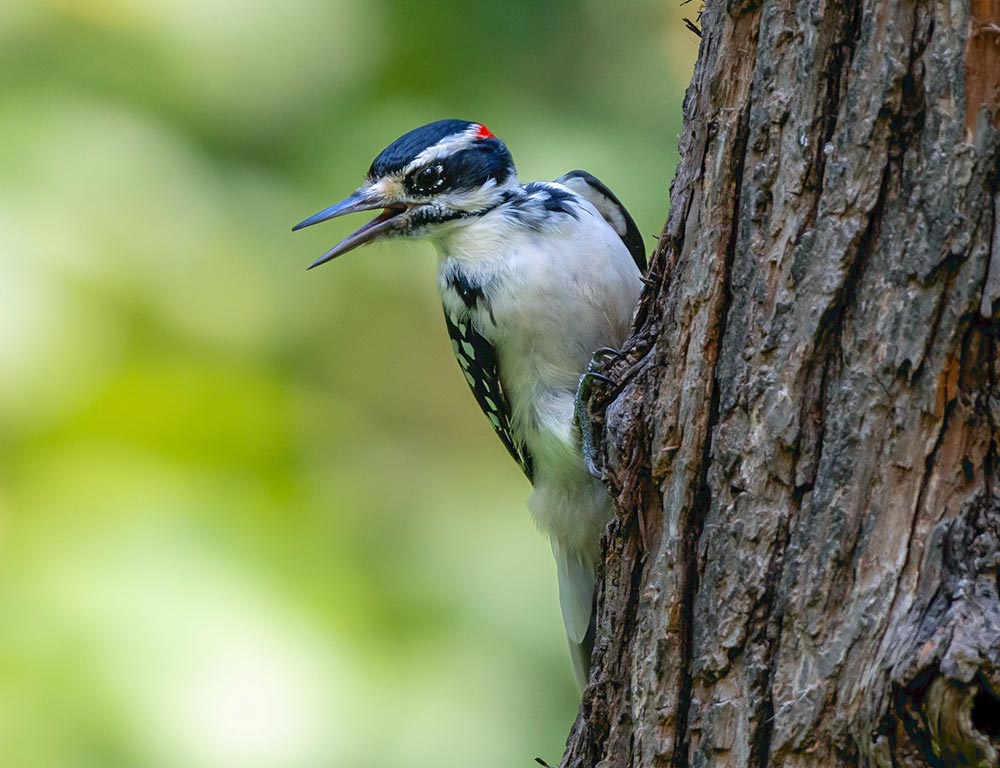
- Scientific Name: Leuconotopicus villosus
- Category: Woodpecker
- Population: Stable
- Life Span: 4-10 years
- Size: 7-10 inches
- Weight: 1.4-3.4 ounces
- Food: Insects, seeds, and berries
- Wingspan: 13-17 inches
- Status: Least Concern
The Hairy Woodpecker, a close relative to the Downy Woodpecker, stands out for its larger size, black and white plumage, and robust, chisel-like bill perfectly suited for drilling into tree bark in search of insects.
Thriving in diverse environments such as forests, woodlots, and suburban areas, these woodpeckers showcase remarkable adaptability.
Their acrobatic foraging style involves expertly navigating tree trunks and branches, diligently seeking out insects and larvae hidden within the bark.
This adaptability and their versatile diet and ability to thrive in various habitats contribute significantly to the Hairy Woodpecker’s stable and widespread population.
As resilient and resourceful avian foragers, they play a vital role in maintaining ecosystem health across the varied landscapes they inhabit.
6. Northern Flicker
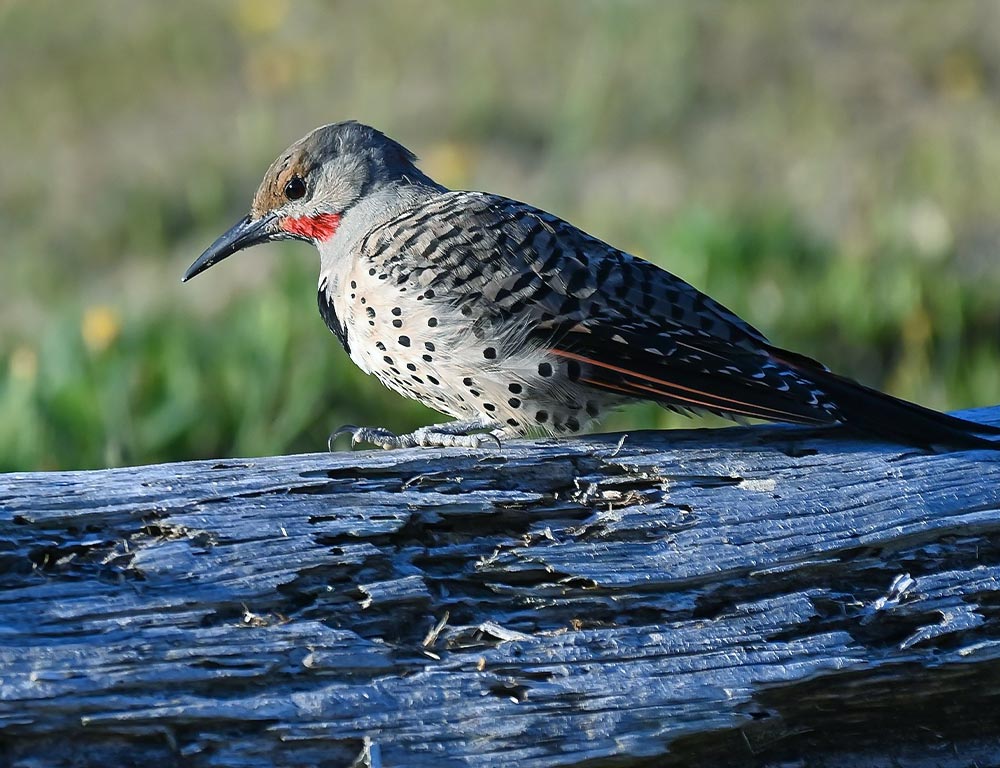
- Scientific Name: Colaptes auratus
- Category: Woodpecker
- Population: Abundant
- Life Span: 6-7 years
- Size: 11-14 inches
- Weight: 3-5.5 ounces
- Food: Insects, fruits, seeds, and ants
- Wingspan: 16-20 inches
- Status: Least Concern
The Northern Flicker is a distinctive woodpecker with a brown body, spotted underparts, and a red crescent on the nape. Unlike many woodpeckers, they often forage on the ground for ants and other insects.
Northern Flickers are known for their unique “flicker” call and drumming sounds during the breeding season. They are adaptable birds found in various habitats, including woodlands, open areas, and urban landscapes.
Their diet includes both insects and plant matter, making them versatile foragers. The Northern Flicker is a common and widespread woodpecker in Virginia.
7. Yellow-bellied Sapsucker
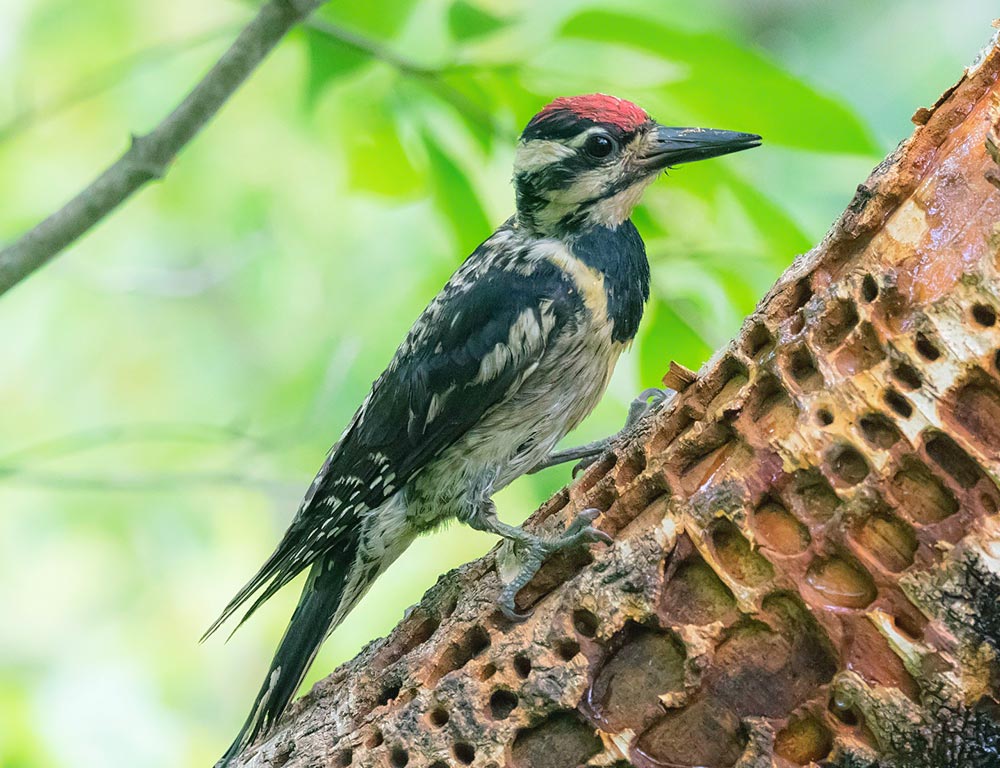
- Scientific Name: Sphyrapicus varius
- Category: Woodpecker
- Population: Stable
- Life Span: 4-8 years
- Size: 7-9 inches
- Weight: 1.5-2.5 ounces
- Food: Sap, insects, and fruit
- Wingspan: 13-16 inches
- Status: Least Concern
The Yellow-bellied Sapsucker is a migratory woodpecker known for its unique feeding behavior. With a black and white plumage, males have a red throat, and both sexes have a distinctive yellow wash on their bellies.
Unlike other woodpeckers, they feed on sap by drilling rows of small holes in tree bark and then consuming the sap and insects attracted to it.
This species is typically found in mixed coniferous-deciduous forests and is known for its distinctive drumming sounds during the breeding season.
8. Red-bellied Woodpecker
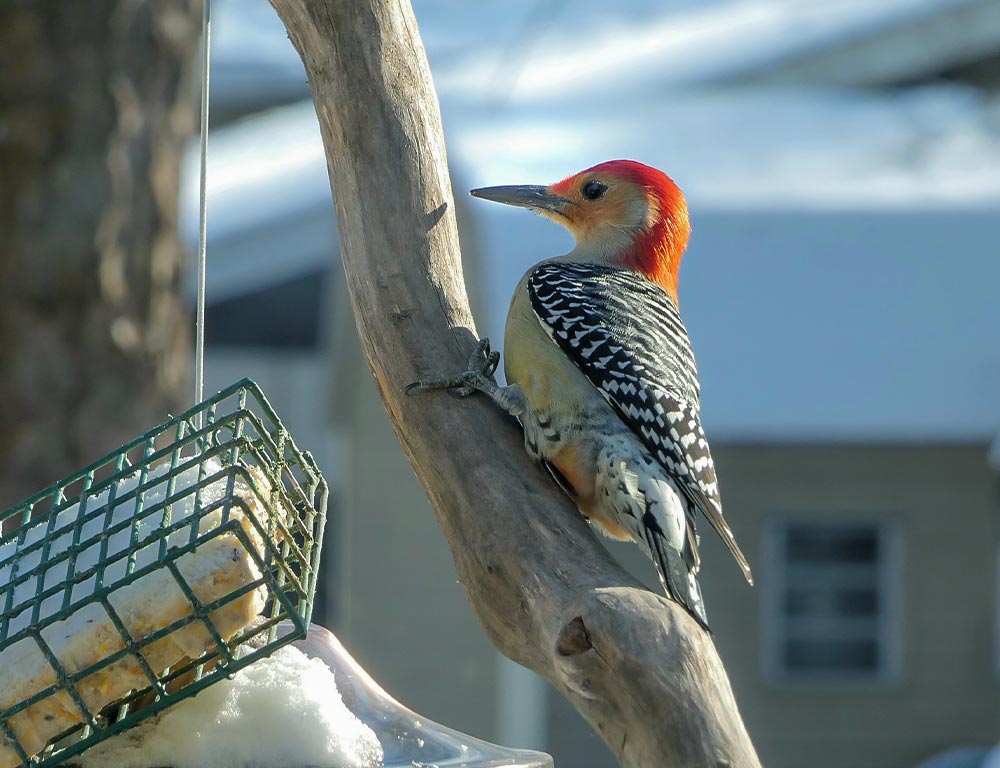
- Scientific Name: Melanerpes carolinus
- Category: Woodpecker
- Population: Abundant
- Life Span: 5-10 years
- Size: 9-10.5 inches
- Weight: 2-3 ounces
- Food: Insects, fruits, seeds, and nuts
- Wingspan: 13-16 inches
- Status: Least Concern
Despite its name, the Red-bellied Woodpecker boasts only a subtle reddish hue on its belly, while its distinctive red crown captures attention.
Thriving in diverse habitats like woodlands and suburban areas, these woodpeckers showcase adaptability in their foraging behaviors.
Armed with strong bills, they skillfully climb tree trunks and branches for a varied diet, including insects, fruits, seeds, and nuts. This adaptability has proven to be a key factor in their abundant population across Virginia.
Their ability to navigate different environments, coupled with a versatile diet, not only underscores their ecological importance but also highlights their resilience in adapting to the ever-changing landscapes within the state.
9. Lewis’s Woodpecker
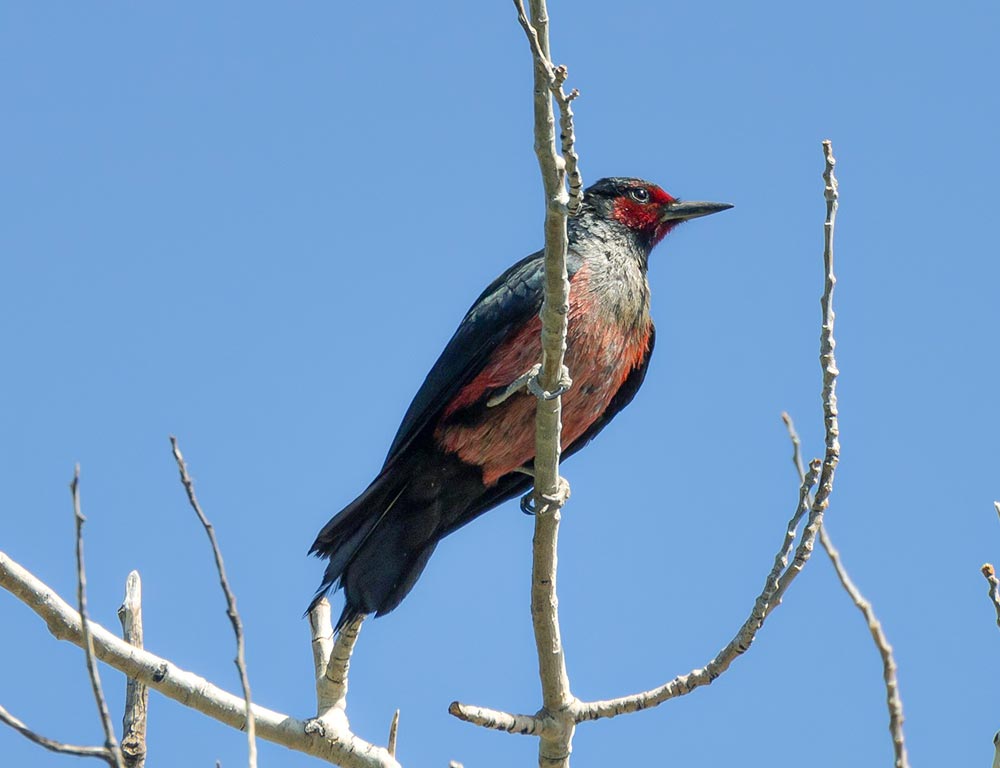
- Scientific Name: Melanerpes lewis
- Category: Woodpecker
- Population: Declining
- Life Span: 6-8 years
- Size: 10-11 inches
- Weight: 4-6 ounces
- Food: Insects, berries, and acorns
- Wingspan: 18-20 inches
- Status: Near Threatened
Lewis’s Woodpecker is a unique species with dark plumage, a pink-red belly, and a gray collar.
Unlike typical woodpeckers, they catch insects on the wing and forage extensively for berries and acorns. Their habitats include open woodlands and forest edges.
Unfortunately, their population is declining due to habitat loss and competition for nesting sites. Conservation efforts are vital to preserving the distinctive Lewis’s Woodpecker in Virginia.
How to Preserve Woodpeckers of Virginia?
Preserving the woodpeckers of Virginia is crucial for maintaining the ecological balance and biodiversity of the region. These charismatic birds face threats from habitat loss, climate change, and human activities.
Woodpeckers are vital in Virginia’s ecosystems, contributing to insect control and overall forest health. To ensure their survival, concerted efforts are needed to address their challenges.
Habitat Conservation
Preserve and restore mature forests, particularly those with dead or decaying trees, as they provide essential nesting and foraging sites for woodpeckers.
Reduce Habitat Fragmentation
Minimize the fragmentation of woodpecker habitats by promoting connected landscapes and corridors, enabling these birds to move freely between suitable areas.
Mitigate Climate Change Impact
Address the impacts of climate change by supporting initiatives that aim to reduce greenhouse gas emissions, as shifts in temperature and precipitation patterns can affect woodpecker habitats.
Raise Awareness
Educate the public about the importance of woodpeckers in the ecosystem. Encourage bird-friendly practices in residential areas, such as providing nest boxes and avoiding the removal of dead trees.
Monitor and Research
Invest in research programs to better understand woodpecker populations, behaviors, and threats. Regular monitoring can provide valuable data for conservation strategies.
Collaborate in Conservation Efforts
Encourage collaboration among government agencies, conservation organizations, researchers, and local communities. Collective efforts are essential for implementing effective conservation measures and policies.
By implementing these strategies, we can contribute to preserving woodpeckers in Virginia, ensuring their continued presence and the health of the ecosystems they inhabit.
Wrapping Up
In the symphony of Virginia’s natural landscapes, woodpeckers are vital players, their vibrant plumage and unique behaviors weaving a tale of ecological significance.
Preserving these avian wonders requires a collective commitment to habitat conservation, awareness, and collaboration.
As stewards of our environment, safeguarding woodpecker habitats and addressing the challenges they face ensures a harmonious balance in Virginia’s biodiversity.
Through our combined efforts, we can secure a future where the drumming sounds and vibrant presence of woodpeckers remain an integral part of the Old Dominion’s natural tapestry. Thank you very much.